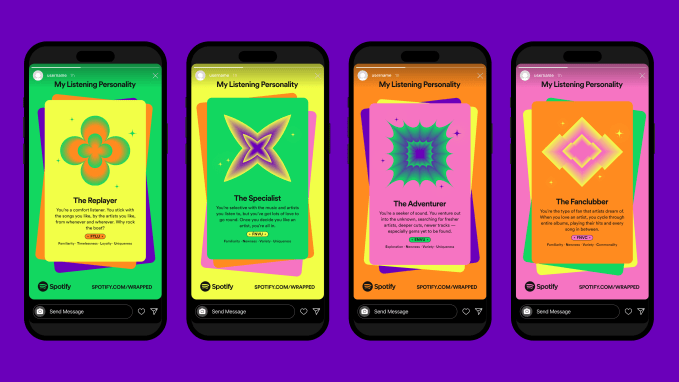Category: TECHNOLOGY
Adtech antitrust class damages claim filed against Google in UK — seeking up to $16.3BN
Litigation against Google and its parent entity Alphabet being brought in the UK on behalf of thousands of digital publishers — seeking up to £13.6 billion (~$16.3BN) in damages on their behalf for alleged anti-competitive behavior related to Google’s adtech practices — has been filed with the Competition Appeal Tribunal (CAT).
“The claim alleges that Google abused its dominant position in the market for online advertising, earning super-profits for itself at the expense of the tens of thousands of publishers of websites and mobile apps in the UK,” runs a press release accompanying news of today’s filing at the CAT.
The competition class-action style suit, which includes a parallel European Economic Area (EEA) claim in the Netherlands, was announced earlier this fall. That EEA-wide multi-billion Euro claim is expected to be filed in early 2023, per Geradin Partners, one of the law firms involved in the legal action.
City litigation firm Humphries Kerstetter is also acting on the claim — which is being funded by litigation funder, Harbour.
While Claudio Pollack, a former director of the UK’s media and comms regulator, Ofcom, is named as heading the claim — as the representative for the class of businesses allegedly damaged by Google’s actions.
The lawsuit will argue that Google has abused its dominance of adtech infrastructure to dictate terms, control pricing and deploy self preferencing that has damaged thousands of businesses that have had little choice but to use its tools if they wish to generate revenue from advertising.
The suit is being brought on behalf of around 130,000 businesses publishing around 1.75M websites and apps in the UK which the litigation claims have been harmed by Google’s anti-competitive practices.
Economic analysis produced to support the claim suggests Google’s practices may have reduced advertising revenues by up to 40% for some companies.
£13.6BN is an estimate of the total loss to those 130k businesses since January 1, 2014 to date.
The claimants can point to enforcement last year by France’s competition watchdog — which found Google had abused a dominant position for ad servers for website publishers and mobile apps and fining it up to €220 million for a variety of self-preferencing abuses and also extracting a series of interoperability commitments.
Google’s adtech stack — and certain other ad-related practices — remain under investigation by both EU and U.K. competition authorities.
But European web and app publishers evidently aren’t waiting around for further regulatory smackdowns — not least as they’re hoping to force Google to fork over major damages for what the class action style suits alleges are “serious” anti-competitive practices.
In a statement on the suit, Pollack said: “The marketplace for online advertising is sophisticated, technical and highly automated. Advertising is sold in a fraction of a second in a process which is designed to match the product being advertised with the profile of an individual visiting a website. Third party platforms operate on both sides of the marketplace matching supply with demand and — in an ideal world — ensuring the market operates efficiently and effectively. Unfortunately, it is now well established that this market has developed in a way that is primarily serving Google.”
In another statement, Damien Geradin, founding partner of the eponymous law firm, added: “While the value of the claim we are bringing is substantial, we believe the matter is about much more than money. For years Google has been denying companies in the UK and Europe and beyond, including the local press and the publishers of community focused websites, the chance to earn a proper income by way of advertising.
“As well as bringing Google to account the parties who have lost out need proper compensation, something a CAT claim can achieve at no cost to those parties.”
Google was contacted for a response to the development. The company previously dubbed the litigation “speculative and opportunistic”.
In a further statement emailed to TechCrunch today it said:
Google works constructively with publishers across Europe — our advertising tools, and those of our many adtech competitors, help millions of websites and apps fund their content, and enable businesses of all sizes to effectively reach new customers. These services adapt and evolve in partnership with those same publishers.
While Google is keen to dismiss the legal challenge as baseless, the UK’s Competition and Markets Authority (CMA) has expressed major concerns about dysfunction in the digital ad market — following a deep dive investigation it kicked off in 2019.
Its final report, published in July 2020, concluded that the market power of Google and Facebook was so great a new regulatory approach (and dedicated oversight body) was needed to address what it summarized as “wide ranging and self reinforcing” concerns.
However the UK government has so far failed to bring forward the necessary legislation to enable that reboot — which may be another factor driving antitrust class action litigation.
In the meanwhile, a planned adtech stack migration by Google away from third party cookie-based tracking (aka its Privacy Sandbox proposal) remains under close regulatory supervision by the CMA — which stepped in following fresh objections by publishers concerned the move would further entrench the adtech giant’s market dominance.
Adtech antitrust class damages claim filed against Google in UK — seeking up to $16.3BN by Natasha Lomas originally published on TechCrunch
https://techcrunch.com/2022/11/30/google-adtech-antitrust-lawsuit-uk/
Spotify Wrapped 2022 arrives with new features like your ‘Listening Personality,’ 40K+ Artist Messages
Spotify Wrapped 2022 has officially arrived. Though other music services, including Apple Music and YouTube Music, now put together their own year-end retrospectives, Spotify’s personalized and interactive Wrapped experience for its users, creators and podcasters remains the one to beat. The secret to its ongoing success is how it goes beyond simply offering a summary of top songs or artists to also include fun, shareable elements for music and audio fans to explore, post to social media and compare with their friends.
The Wrapped experience has grown in popularity over the years. In 2017, some 30 million Spotify users accessed Wrapped; by last year, that figure had grown to more than 120 million. In addition, there were nearly 60 million shares of Wrapped stories and cards across social platforms in 2021.
Consumer interest in Wrapped isn’t just about the data itself but also the way that Spotify personalizes the data to its users and presents it in clever ways. Last year, for example, Wrapped included an “Audio Aura,” which showed listeners their top two “moods” based on their listening behavior.
This year, the new addition of note is something Spotify calls your “Listening Personality.”
Created with obvious inspiration from the classic Myers-Brigg personality test and its four-letter codes, the “Listening Personality” feature also introduces a four-letter combination for the user that translates into one of the 16 personality types Spotify has created. For instance, fans who quickly stream new releases and who are often ahead of trends might find themselves dubbed an ENPC, or an early adopter, while fans who love to stream music from other parts of the world might be labeled an ENLC, or a voyager.
Image Credits: Spotify
“The way we listen to music says a lot about us and your Listening Personality not only tells you about the music you listen to but what that says about your music taste,” explains Spotify VP of Product Development Babar Zafar, who leads the team that creates the Wrapped experience.
People’s personality type will be based on a combination of the music they stream and a selection of specific traits — like their tendency to discover new music, the average age of the songs they listen to, the range of artists they listen to and how their listening resembles or differs from others. Each of the 16 possible Listening Personalities is given its own colorful card designed for re-sharing to social media or for messages to friends.
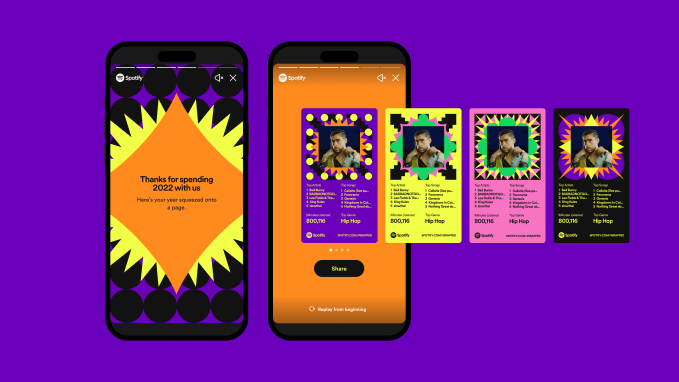
Image Credits: Spotify
This new feature is being integrated with Snapchat, too, allowing fans to unlock a personalized Snapchat Lens that reflects their “Listening Personality.” Snapchat users can also take advantage of Wrapped-themed apparel for Bitmojis. And with a new GIPHY partnership, users can access custom Wrapped-themed GIFs.
Another Wrapped 2022 feature is something called “Audio Day,” which is an interactive story that describes an individual’s listening trends from morning through evening.
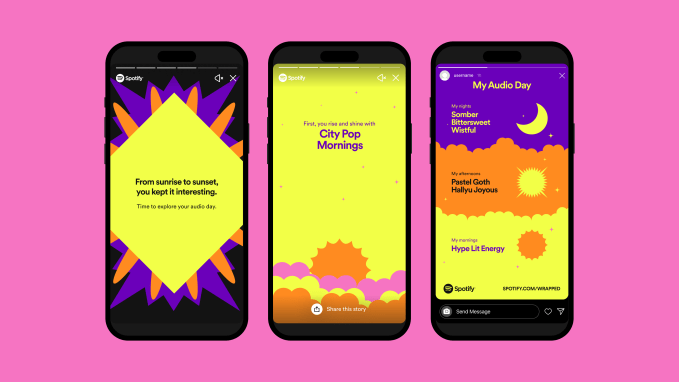
Image Credits: Spotify
Meanwhile, Wrapped’s popular “Top Song” feature is being expanded this year to offer a few more insights, like how many times users listened to their top song and on which day of the year they listened the most.
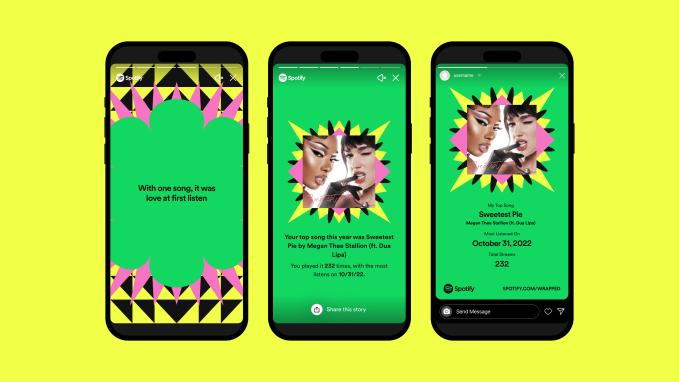
Image Credits: Spotify
Plus, users will receive their usual year-end updates about their top artists, songs, genres, podcasts and minutes listened as well as their Top Songs 2022 playlist.
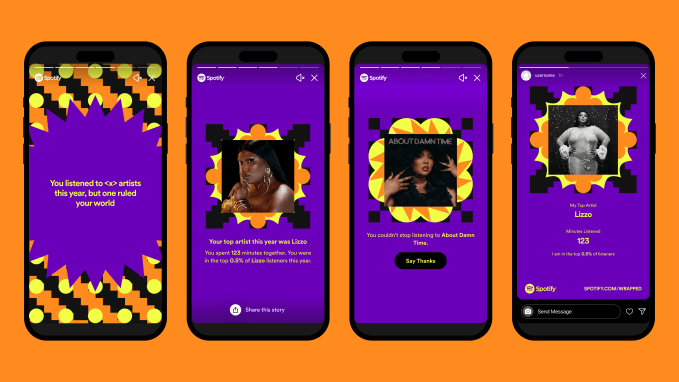
Image Credits: Spotify
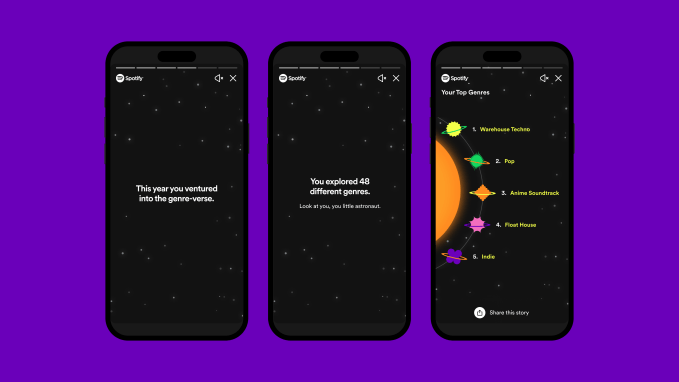
Image Credits: Spotify
Despite the many ways to share and interact with Wrapped, Spotify admits it can’t track the full reach of Wrapped as it notices its younger users will often snap a photo of their phone screen for private sharing, rather than — or in addition to — posting their Wrapped to social media.
To help address this, Spotify this year is now more deeply integrating with various messaging platforms as part of its drive to get Wrapped shared — and tracked — in as many places as possible. While users could always share Wrapped on social media, Wrapped 2022 is adding direct integrations with WhatsApp, Instagram Direct Messages, Facebook Messenger and Line, in order to better cater to those users who prefer to share their Wrapped more privately.
Spotify is also leveraging its more recent Roblox integration, Spotify Island, as part of this year’s Wrapped.
In its virtual world, Roblox users can go on Wrapped-inspired quests, play games, shop virtual merch and use a photo booth feature with 12 different artists, including Bizarrap, Black Sherif, CRO, Doechii, Eslabon Armado, Miranda Lambert, NIKI, Stray Kids, SUNMI and Tove Lo.

Image Credits: Spotify
The company is also doubling down on another feature introduced last year: artist video messages.
Taking a cue from celeb social apps like Cameo and the popularity of short-form video, as on TikTok, Spotify last year had worked with 170+ artists to create short video messages where they thank fans for including them in their listening throughout the year. This year, the company expanded the video message feature, “Your Artist Messages,” to more than 40,000 music creators, including well-known names like Taylor Swift, Billie Eilish, J Balvin, Måneskin, Shania Twain, Pusha T and others.
Users can scroll through the video messages in a vertical, full-screen interface, similar to TikTok.
Spotify says users will see these videos if they have at least two artists with “thank you” videos in their top artists. In other words, the feature is limited to those fans who are most engaged with the artists. While the feature is sure to boost fan engagement, it’s a shame the artists can’t also post their videos somewhere else on Spotify — like a Stories section on their own Artist profile, for example. Spotify says users can see up to a maximum of 10 artists’ “thank yous” in Wrapped.
Wrapped will also get its own hub on Spotify’s mobile app, where streamers can browse merch and concert tickets from their top artists.
As in past years, creators and podcasters will have their own Wrapped experiences, available directly from Spotify for Artists, Spotify for Podcasters and Anchor. Artists will gain insight into their streams, their most-shared lyrics, how many fans had them in their top artists, fans’ Listening Personalities and more. Podcasters will gain insights on listens and follows, how many fans had their podcast in their top 5 or 10, their top episode overall, placement on the charts and more.
Of course, as part of Spotify’s year-end review, the company also highlighted the top artists and creators on its platform, both globally and on a per-country basis.
This year, the most-streamed artist globally was Bad Bunny, followed by Taylor Swift, Drake, The Weeknd and BTS. The most-streamed songs globally were “As It Was” by Harry Styles, “Heat Waves” by Glass Animals, “STAY (with Justin Bieber)” by The Kid LAROI, “Me Porto Bonito” by Bad Bunny featuring Chencho Corleone, and “Tití Me Preguntó” by Bad Bunny. And the most-streamed albums globally were “Un Verano Sin Ti” (Bad Bunny), “Harry’s House” (Harry Styles), “SOUR” (Olivia Rodrigo), “=” (Ed Sheeran) and “Planet Her” (Doja Cat).
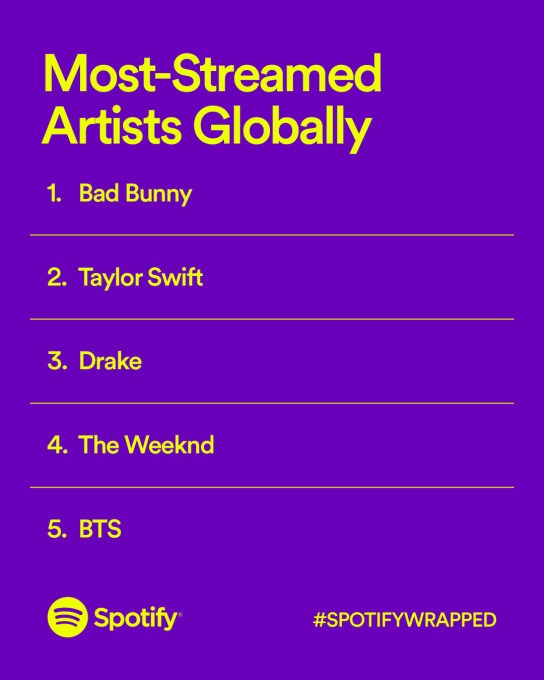
Image Credits: Spotify
In reference to Bad Bunny’s chart dominance — the artist is now the most-streamed globally for the third year in a row — Spotify points out that an average of 50% of users globally stream at least one Latin song per month on its service, equating to around 215 million users around the world. To celebrate, Spotify will turn its green heart to Bad Bunny’s red heart when users “like” a Bad Bunny track during the next week.
“You can see it’s far more than a genre. The average monthly streams of Latin music in 2022, so far, is over 24 billion streams,” said Spotify’s Global Head of Public Affa1irs Dustee Jenkins. “A massive number — and just in the U.S., 1 in 10 streams is Latin music,” she noted.
In the U.S., the most-streamed artists were led by Drake in first place, followed by Taylor Swift, Bad Bunny, Kanye West and The Weeknd. The top songs were “As It Was” by Harry Styles, “Heat Waves” by Glass Animals, “Bad Habit” by Steve Lacy, “Me Porto Bonito” by Bad Bunny featuring Chencho Corleone and “First Class” by Jack Harlow.
Top albums were “Un Verano Sin Ti” (Bad Bunny), “Harry’s House” (Harry Styles), “Dangerous: The Double Album” (Morgan Wallen), “Midnights” (Taylor Swift) and “SOUR” (Olivia Rodrigo).
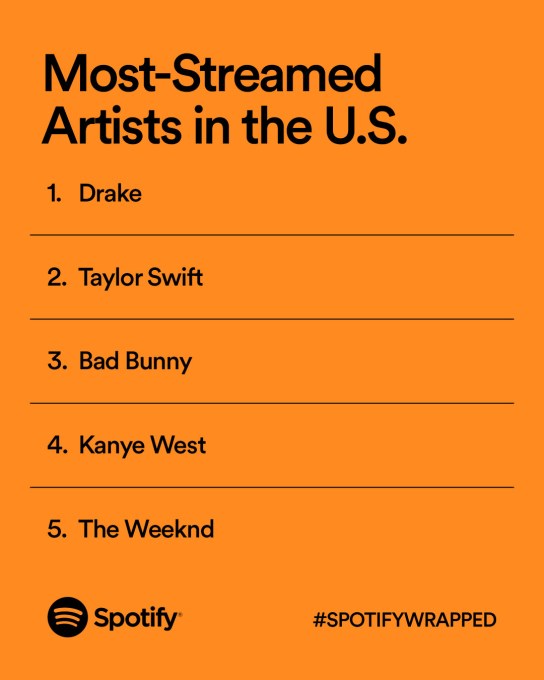
Image Credits: Spotify
Notably, Swift’s “Midnights” album only arrived last month and already broke numerous records, including becoming the most-streamed album in a single day. Not surprisingly then, Swift became 2022’s “most viral” artist globally, ahead of The Weeknd, Bad Bunny, BTS and Lana Del Rey, based on shares from Spotify to social platforms.
Spotify also highlighted its most popular podcasts for the year, which, globally, were led by “The Joe Rogan Experience” (again!), then “Call Her Daddy,” “Anything Goes with Emma Chamberlain,” “Caso 63” (All Languages) and “Crime Junkie.” The U.S. list also saw Rogan and “Call Her Daddy” in the top two spots, followed by “Crime Junkie,” “The Daily” and “Armchair Expert with Dax Shepard.”
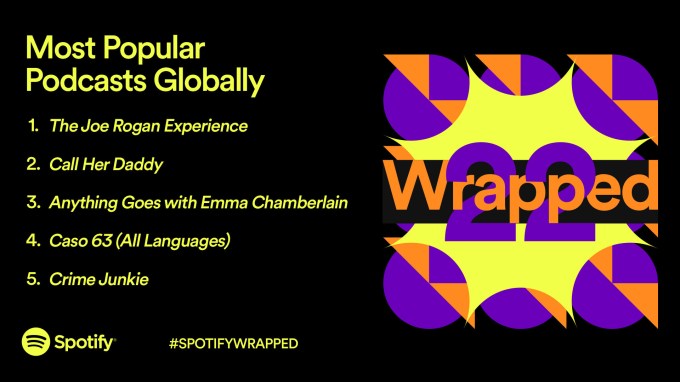
Image Credits: Spotify

Image Credits: Spotify
And though a fairly new addition in the U.S., Spotify showcased its top audiobooks in a list that didn’t seem to include only current releases. Instead, users’ top books were “I’m Glad My Mom Died” by Jennette McCurdy, “Harry Potter and the Sorcerer’s Stone” by J.K. Rowling, “It Ends with Us” by Colleen Hoover, “Atomic Habits” by James Clear and “The Subtle Art of Not Giving a F*ck” by Mark Manson.
The company said it will also market Wrapped through out-of-home campaigns, including things like a word search that appears in billboards in LA and Brooklyn, and more. Spotify additionally partnered with FC Barcelona, which will result in 2022 Wrapped videos from players, including Robert Lewandowski, Alexia Putellas, Pedri and Ansu Fati, shared to social media.

Image Credits: Spotify
Wrapped 2022 is available only through Spotify on mobile devices.
Spotify Wrapped 2022 arrives with new features like your ‘Listening Personality,’ 40K+ Artist Messages by Sarah Perez originally published on TechCrunch
Pangea Cyber wants to simplify security for developers with an API approach
When developers are creating a new application, they may build security features over time or take advantage of commercial offerings or open source libraries to implement certain security functions such as authentication or secrets management. Pangea Cyber wants to change that with an API-driven approach to adding security to an application, making it as easy as adding a few lines of code.
The company’s approach has attracted a fair bit of investor attention with over $50 million raised since it launched last year, an amazing amount of funding in a short amount of time, especially in the current funding environment. The latest round is a $26 million Series B.
Company co-founder and CEO Oliver Friedrichs says they decided to offer a security service for developers in the same way that Stripe offers payment services or Twilio offers communications.
“We’re calling this SPaaS. So essentially Security Platform as a Service, where we’re going to be providing dozens of different security building blocks that are all API-driven that developers can easily embed in their applications,” Friedrichs told TechCrunch.
The services start with authentication and authorization as basic building blocks, but then include more sophisticated elements like logging, scanning files for malicious activity, storing secrets and so forth.
“There’s a lot of things that applications need that are securely related. And right now they’re scattered across many open source and a fragmented list of commercial offerings. We’re looking to provide them all in one place,” he said.
There are developer-oriented pieces like Auth0 (acquired by Okta in 2021) providing authorization or HashiCorp providing secrets management, but there hasn’t been this hub of security services aimed specifically at developers, Friedrichs says.
And he believes that developer focus is what separates his company from the pack. “That’s really where this developer-first delivery model is important and unique, and it doesn’t really exist. For decades now, we have built all these traditional shrink-wrapped products for end users across the entire security industry, but we haven’t built things that are API only or API first that can be plugged in by developers,” he said.
The company already has 40 employees as it attacks this problem, and with multiple startups including Phantom Cyber behind him, Friedrichs has deep experience in building companies. He says, even with the economic downturn, he believes his company will thrive.
“Cybersecurity is one of those sectors that’s always resilient and always needed. While there’s a correction in valuations, we rarely see people removing cybersecurity. In fact, it continues to grow and evolve,” he said.
He says as he grows the company, diversity is a big priority for him, but even with all his experience as a founder, it remains challenging. “We focus on it deliberately across the management team and across our recruiting team. We have a full time recruiter in-house, which is unusual for this early stage, as well as outside resources, and we have conscious conversations around it,” he said.
“Now. Is it easy? It’s not easy, right? Despite how hard you try, you can’t always meet those goals. But we are trying and I think that step number one is to make sure that that’s an objective that we do want to meet, [while understanding that] we can always do better.”
Today’s $26 million Series B investment was led by GV with participation from Decibel and Okta Ventures along with existing investors Ballistic Ventures and SYN Ventures. The company has now raised a total of $52 million. Okta’s participation is noteworthy, because as previously noted, it acquired a developer-driven authorization piece in Auth0.
Pangea Cyber wants to simplify security for developers with an API approach by Ron Miller originally published on TechCrunch
Here’s your chance to show off your expertise at TechCrunch’s founder summit
Do you have what it takes to present at TechCrunch Early Stage on April 20 in Boston, Massachusetts? We’re looking for trendsetting, game-changing, later-stage startup founders and ecosystem experts — of every stripe — to apply for the opportunity to share their hard-won expertise at our annual founder summit.
An entrepreneurial bootcamp experience, TC Early Stage connects people in the beginning or early stages of their startup journey with top industry experts for hands-on training. Presenting at this event is an opportunity to align yourself with TechCrunch and position yourself as a thought leader for hundreds of early-stage entrepreneurs. Apply here now.
You have until January 6 to submit an application outlining the content you’d like to present. TechCrunch will vet each application and select the top contenders to participate in an Audience Choice voting round where TechCrunch readers will choose the sessions they want to see most at TC Early Stage.
Our call for outstanding content is officially open, and here are the important dates to keep in mind:
- Application deadline: January 6
- Notify Audience Choice participants: January 23
- Voting period: January 30 through February 17
- Notify winners: By February 22
If you can deliver content that elicits this kind of attendee feedback, we want to hear from you.
“Early Stage offered a great variety of sessions and speakers — top investors, founders and credible subject-matter experts — who gave unique insights based on personal experience. You get great mentorship through attending the Early Stage sessions. It’s like a mini masterclass in entrepreneurship.” — Ashley Barrington, founder, MarketPearl
Show us your content — apply today!
TC Early Stage, which takes place on April 20, 2023, in Boston, Massachusetts, provides access to essential information, resources and community connections to help nascent entrepreneurs reach their potential. Grab your ticket now — just $149 for the next 30 founders — and join us in Boston!
Is your company interested in sponsoring or exhibiting at TC Early Stage 2023? Contact our sponsorship sales team by filling out this form.
Here’s your chance to show off your expertise at TechCrunch’s founder summit by Lauren Simonds originally published on TechCrunch
https://techcrunch.com/2022/11/30/early-stage-2023-call-for-content/
Let’s Encrypt issues 3 billion HTTPS certificates
Non-profit certificate authority Let’s Encrypt hit a major milestone earlier this month: it issued its three billionth HTTPS certificate.
Let’s Encrypt project was founded in 2013 to provide websites with free SSL and TLS certificates needed to enable HTTPS and encrypted communications. The organization, run by the Internet Security Research Group (ISRG) and backed by the Electronic Frontier Foundation, issued its first HTTPS certificate in September 2015 for none other than its own domain.
The IRSG announced this week that Let’s Encrypt issued its three billionth certificate earlier this month and is now providing TLS to over 309 million domains, an increase of 12% compared to the year earlier.
While Let’s Encrypt took five years to issue its billionth certificate, it has reached the three billion milestone just two years later.
The ISG also revealed in its 2022 annual report that 82% of web pages loaded by Firefox are using HTTPS globally. When Let’s Encrypt was founded, only 38 percent of website page loads were served over an HTTPS-encrypted connection.
This growth comes as Let’s Encrypt finds itself trusted and integrated by more significant players in the browser, operating system and cloud markets, including Apple, Google, Microsoft, Oracle, and more.
So what’s next for Let’s Encrypt? The organization is aiming to make certificate renewal far easier for websites, especially if the organization is forced to revoke a certificate, such as if a website’s server is compromised. Let’s Encrypt was forced to revoke more than three million certificates because of a bug in its domain validation and issuance software in March 2020, and in January this year revoked millions of active certificates due to “irregularities” in the code.
ISRG executive director Josh Aas said its new specification for renewing certificates is “making its way through the IETF standards process so that the whole ecosystem can benefit, and we plan to deploy it in production at Let’s Encrypt shortly.”
Let’s Encrypt’s ultimate goal is to bring the web up to a 100% encryption rate. While we’re still a way away, this latest milestone suggests it’s more in reach than ever before.
Let’s Encrypt issues 3 billion HTTPS certificates by Carly Page originally published on TechCrunch
https://techcrunch.com/2022/11/30/lets-encrypt-https-three-billion/
New Fare Partners is latest female-led VC to close first fund
Venture capital firms have a tight grasp on their dry powder for now, but amid the investment slowdown are a flurry of new funds being announced, many of them from female-led venture capital firms.
The latest is New Fare Partners, co-founded by Elly Truesdell and Hallie Bonnar, who secured $20 million in capital commitments for its inaugural fund investing in early-stage food and beverage businesses.
The firm was launched in early 2022. Truesdell, general partner, was previously Whole Foods Market’s global director of local brands and product innovation. It was largely through that experience, especially working with brands to get them on store shelves, where she said venture capital became a calling.
“My whole life at Whole Foods was dedicated to young emerging brands, helping accelerate young companies that we brought in from areas that had whitespace or category growth,” Truesdell told TechCrunch. “I became this person in the natural foods industry that people came to when they were looking to launch their product. When I was getting ready to leave Whole Foods, I had a lot of opportunities presented to me in venture and private equity.”
From there, she went on to operate her own company, a food private label and co-packing business called Canopy Foods, before joining VC firm Almanac as a partner. Most recently, she co-founded Made by Nacho, a crafted cat food brand, with renowned chef and restaurateur Bobby Flay.
Truesdell and Bonnar, who started her career in the fintech industry, have worked together over the past five years, having first met at Canopy Foods. Bonnar later joined Truesdell at Almanac, where Bonnar was marketing lead. She also worked with Truesdell at Made by Nacho as head of marketing.
“Having that co-packing operating experience has really proven invaluable in the next phases of our work and as our role as investors now, including what it takes to bring a product to market within food,” Bonnar told TechCrunch. “We also were able to accelerate growth for a number of small food brands by jumping in and creating strategies for them. Our value-add galvanized this idea that we’ve had for a long time of what our own funds would be in the future.”
In addition to Bobby Flay, New Fare’s backers includes a group of mainly former founders, including Walter Robb, former co-CEO of Whole Foods Market; Kathleen King, founder of Tate’s Bakeshop; Gary Hirshberg, founder of Stonyfield Organic; Andrew Abraham, founder of Orgain; Gabi Lewis, founder of Magic Spoon; Charlie Sweat, former CEO of Earthbound Organic; David Barber, partner at Astanor Ventures, co-owner/founder of Blue Hill and Almanac; and Nick McCoy, founder and managing director of Whipstitch Capital.
Truesdell and Bonnar expect to make between 16 and 20 investments from their first fund and have made eight already. These include Made by Nacho, convenience retailer Foxtrot, Mexican omnichannel brand Tacombi and functional chocolate bar brand Mid-Day Squares.
Meanwhile, the market has been a tough one to raise in, “certainly a first-time fund,” Truesdell said.
“The nice thing has been that there’s a real understanding and acknowledgement that valuations have been too high, especially in food tech,” she added. “There are some positive feelings around what’s coming for consumer foods and then being priced more appropriately to the right growth expectations. Also, maybe there was a real upside to investing in a fund that launched in 2022 versus 2021.”
Truesdell also noted that New Fare being women-led and co-founded is still rare in the venture capital business. Women traditionally comprise less than 15% of decision-makers at VC firms, but firms like New Fare are grabbing some of that capital for funds.
For example, last week, Pact, a new seed VC fund, launched with $36 million in capital commitments to back early-stage startups across Europe. That was preceded by Magdalena “Mags” Kala raising around $30 million for her first fund as a solo GP of Double Down, a firm focused on early-stage consumer startups in the web3 space. Similarly, Switzerland-based Privilège Ventures launched its fourth fund of just over $20 million targeting women-led early-stage startups across Europe.
In addition, Curate Capital, a Houston-based venture capital fund, raised $15 million for its first fund, closing on it over the summer. Carrie Colbert, an energy executive-turned-investor, started the fund in 2021 and said she attracted 50% more in capital commitments.
Though it wasn’t without some challenges, including finding LPs who would invest in a smaller fund, Colbert told TechCrunch. However, that did give her a chance to meet some women who were interested in being investors.
And as my colleague, Dominic-Madori Davis reported in October, addressing the gender imbalance in venture capital firms will hopefully lead to more gender balance among investments when all of that dry powder is deployed in coming years.
Colbert agrees, and purposefully brought in over 80% female limited partners, most of whom are first-time investors.
“What sets us apart is having this kind of ground movement of women supporting women and so for that reason, I think it’s a really good way to get people engaged and involved,” she said. “Maybe I was too small to attract a big institutional check, but I was small enough that we were approachable to welcome new investors to the fold.”
New Fare Partners is latest female-led VC to close first fund by Christine Hall originally published on TechCrunch
https://techcrunch.com/2022/11/30/new-fare-partners-first-fund/
‘If you have too much, you can drown’ How tech PR’s job changed in 2022
Hello and welcome back to Equity, a podcast about the business of startups, where we unpack the numbers and nuance behind the headlines.
This is our Wednesday show, where we niche down to a single person, think about their work and unpack the rest. This week, Natasha interviewed Vijay Chattha, a startup comms leader who has spent over 20 years in the storytelling world. Chattha is the CEO and founder of VSC and founding partner of VSC Ventures, a $21 million investment vehicle to back startups.
Here’s what we spoke about:
- How his clients are reacting to the downturn in terms of their openness, vulnerability, and general hunger to tell their story
- The difference between pitching a VC and pitching a journalist (lol)
- How startup’s goal with media coverage can sometimes inherently clash with the media’s goal to cover a startup (and why we disagree on the importance of disclosing valuations)
- The best framework for the different types of media form out there, from Twitter to billboards to earned media.
- How the #MeToo movement impacted leadership styles and changed accountability for the better
- If we’re getting closer to a more transparent ecosystem, or more opaque one
- And of course, we end with a lightning round – including but not limited to Chattha’s biggest pet peeve with journalists.
Equity drops every Monday at 7 a.m. PT and Wednesday and Friday at 6 a.m. PT, so subscribe to us on Apple Podcasts, Overcast, Spotify and all the casts. TechCrunch also has a great show on crypto, a show that interviews founders, a show that details how our stories come together and more!
‘If you have too much, you can drown’ How tech PR’s job changed in 2022 by Natasha Mascarenhas originally published on TechCrunch
https://techcrunch.com/2022/11/30/startup-pitching-storytelling-tech-pr-2022/
San Francisco police can now use robots to kill
Last week, we talked about killer robots. That piece was inspired by a proposal that would allow San Francisco police to use robots for killing “when risk of loss of life to members of the public or officers is imminent and outweighs any other force option available to SFPD.” Last night, that proposal passed the city’s board of supervisors with an 8-3 vote.
The language was included in a new “Law Enforcement Equipment Policy” filed by the San Francisco Police Department in response to California Assembly Bill 481, which requires a written inventory of the military equipment utilized by law enforcement. The document submitted to the board of supervisors includes – among other things – the Lenco BearCat armored vehicle, flash-bang grenades and 15 submachine guns.
The inventory also names 17 robots owned by the SFPD – 12 of which are fully functioning. None are designed specifically for killing. They’re mostly used to detect and dispose of bombs – something police departments have been doing for years. The language included in the proposal effectively allows for these – or other – robots to kill in order to save the lives of officers or the public.
As we noted last week, the proposal seems to fit the definition of “justified” deadly force. Police in the U.S. are authorized to shoot when a situation meets a number of criteria, including self-defense and cases where others are facing death or serious bodily harm. A robot is not a gun, of course (though we are now aware of robots that sport guns), but the 8-3 vote effectively approves the weaponization of robots in these sorts of cases.
“Robots equipped in this manner would only be used in extreme circumstances to save or prevent further loss of innocent lives,” Allison Maxie, a spokesperson for SFPD said in a statement. Maxie added that robots could be armed with explosives, “to contact, incapacitate, or disorient violent, armed or dangerous suspect.”
Such applications certainly appear to run counter to the purpose for which these robots were both built and acquired. There is precedent for this, however. In July 2016, the Dallas Police Department killed a suspect using a robot armed with a bomb for what’s believed to be the first time in U.S. history. “We saw no other option but to use our bomb robot and place a device on its extension for it to detonate where the suspect was,” police chief David Brown told the press after the incident.
As more robots are being developed for military applications, it’s easy to see how such language could open the door for the acquisition of systems that are weaponized out of the box. Police use of military equipment has become commonplace in U.S. police departments in the wake of the National Defense Authorization Act for Fiscal Year 1997. Section 1033 of the bill allows for the military’s “transfer of excess personal property to support law enforcement activities” for the sake of drug enforcement. Maxie says the SFPD currently has no plans to stick guns on robots.
Last year, the Electronic Frontier Foundation warned of “mission creep” with regards to the use of armed robots, noting,
Time and time again, technologies given to police to use only in the most extreme circumstances make their way onto streets during protests or to respond to petty crime. For example, cell site simulators (often called “Stingrays”) were developed for use in foreign battlefields, brought home in the name of fighting “terrorism,” then used by law enforcement to catch immigrants and a man who stole $57 worth of food. Likewise, police have targeted BLM protesters with face surveillance and Amazon Ring doorbell cameras.
The proposal’s approval appears to run counter to San Francisco’s image as one America’s most liberal cities. The debate around the issue was lively, running more than two hours. It comes at a time when many left-leaning politicians are concerned about appearing antagonistic toward police.
“I think there’s larger questions raised when progressives and progressive policies start looking to the public like they are anti-police,” board member Rafael Mandelman noted during the meeting. “I think that is bad for progressives. I think it’s bad for this Board of Supervisors. I think it’s bad for Democrats nationally.”
SF’s Board of Supervisors Rules Committee chair Aaron Peskin had previously attempted to insert language condemning the use of robots for killing. The line, “Robots shall not be used as a Use of Force against any person” was reportedly crossed out by the SFPD.
Last month Oakland fought a similar battle across the Bay. Their debated ended differently. Following public backlash, the police department wrote,
The Oakland Police Department (OPD) is not adding armed remote vehicles to the department. OPD did take part in ad hoc committee discussions with the Oakland Police Commission and community members to explore all possible uses for the vehicle. However, after further discussions with the Chief and the Executive Team, the department decided it no longer wanted to explore that particular option.
San Francisco Board of Supervisors President used their own debate to warn against the impact of such proposal on people of color. “We continuously are being asked to do things in the name of increasing weaponry and opportunities for negative interaction between the police department and people of color,” he noted during the meeting. “This is just one of those things.”
San Francisco police can now use robots to kill by Brian Heater originally published on TechCrunch
https://techcrunch.com/2022/11/30/san-francisco-police-can-now-use-robots-to-kill/
CommonGround raises $25M for immersive video avatar technology that doesn’t rely on VR gear
The trials and tribulations that a giant company like Meta (née Facebook) has been facing in overcoming skepticism, creating user interest (let alone revenue) and building quality experiences for its all-in metaverse vision highlights just how much work lies ahead for any company working in mixed reality. Today, a startup in that bigger ecosystem, which believes it can fix one aspect of how this works — how we ourselves appear — is announcing some funding along with a beta of its live avatar software that has been years in the making.
CommonGround — an Israeli/Silicon Valley startup that has built technology for people to use their smartphones to scan their faces for responsive, real-time three-dimensional avatars that can be used in video applications — has raised $25 million, money that it is using both to continue developing its tech getting it launched into the world.
Marius Nacht, the co-founder and former chairman of CheckPoint Software, led the round, with VCs Grove, Matrix and StageOne also participating. The latter three are repeat backers: collectively, they invested $19 million in the CommonGround when it was still in stealth mode.
CommonGround actually raised this latest funding a year ago, but it chose to delay announcing until it had a product ready to show. Now, you can go to the site to scan yourself and create an avatar; in Q1 2023, the company plans to release the first application to use that avatar: meeting software where your likeness, or an idealized version of your likeness, will be able to sit around a virtual table to engage and respond to others in the conversation — complete with reactions and movements mirroring those you are making IRL. (For now, you can share the avatars with friends and put them into a dancing animation.)
Like “TrueSelf Scan,” the name of the initial application that’s used to scan a person’s image, the meeting software also will not require a VR headset to use and engage with: users will be “seated” in a room that will be shown on a video screen. Amir Bassan-Eskenazi, the CEO of CommonGround who co-founded the company with Ran Oz, said avatar preview link for now will work for the first 500 people, although it’s not clear how many will be able to speak concurrently on the conferencing app.
Why videoconferencing? The medium definitely had a moment in the spotlight with the arrival and peak of the Covid-19 pandemic and a huge shift of people opting to work remotely. Fast forward to today, with millions of hours in aggregate clocked up on services like Zoom, Microsoft’s Teams, Google’s Meet, WebEx and the many other videoconferencing apps out there, skeptics might argue that what we have on the market today has been good enough.
CommonGround’s bet is that the experience could be better, and when people are presented with an easy way of having that, they will use it.
“There is Zoom and there are phone calls, but we think there is a big aspect of remote meetings [not being addressed by technology today],” said Bassan-Eskenazi. “Our goal is to enable taking experience — closer connections — and making that digital. We think moving video conferencing from 2D to 3D could even make it better than face-to-face.”
The computer vision technology is built from the ground up — a project that seems to have started as early as 2019 and has been complex enough that this launch was postponed from its original target date of 2021. Based around machine learning, CommonGround’s platform is theoretically learning all the time from its users: the more you use it, the more you train it, and the more accurate it becomes.
And to be clear, the startup confirms that the tech is not in any way connected to what others are building around the same concept. One would-be competitor that I found comes from Avatar SDK, which is part of ItSeez3D, which itself was acquired by Intel several years ago — albeit not for this particular piece of technology, at least not at the time of the deal in 2016 (its USPs then were IOT and automotive applications).
Avatars have had a lot of currency in more fun, consumer-focused applications, and there have been a few examples of how AI and computer vision can spark delight in these when they become more anthropomorphic: Apple’s animated memoji, based on your facial expressions, can feel familiar and cute, if a little eery.
But Bassan-Eskenazi believes that avatars also very much have a place in enterprise environments. For one thing, the numbers of calls today that are made with the camera turned off — either because a person does not feel presentable or in the right environment for a call — are one use case: now you can continue to maintain your privacy while still making eye contact and responding to what others are saying, qualities that go a long way towards communication that might otherwise get lost in virtual environments.
And if you think immersive meetings are the future, you may not want to ever have them in VR. Although some have held the new wave of headsets as the answer to more immersive virtual meetings, there’s no question that wearing a headset for extended periods — those work meetings that could last for hours — is uncomfortable.
Whether the idea really catches on with businesses, and is as scalable as CommonGround believes it could be, are still bets that have yet to come good, but investors have been interested not least because of the pedigree of the founders. Between them, Bassan-Eskenazi and Oz have started seven companies, had three IPOs, two exits, and won two Emmy awards for streaming technology. That points to resourcefulness, and artificial intelligence technology with multipurpose potential at the end of the day.
CommonGround raises $25M for immersive video avatar technology that doesn’t rely on VR gear by Ingrid Lunden originally published on TechCrunch
DoorDash lays off 1,250 employees to rein in operating expenses
DoorDash is laying off 1,250 people in an effort to rein in costs, the company’s CEO Tony Xu said in a message to employees on Wednesday. Xu’s message notes that the pandemic presented unprecedented opportunities to serve merchants and consumers, and as a result, DoorDash sped up hiring to catch up with growth. Xu says although most of the company’s investments are paying off, it did not properly manage team growth.
“Most of our investments are paying off, and while we’ve always been disciplined in how we have managed our business and operational metrics, we were not as rigorous as we should have been in managing our team growth,” Xu wrote. “That’s on me. As a result, operating expenses grew quickly.”
This is the most difficult change to DoorDash that I’ve had to announce in our almost 10-year history. Today, we are reducing our corporate headcount and saying goodbye to many talented teammates. https://t.co/xSYUVLwp17
— Tony Xu (@t_xu) November 30, 2022
Xu says that given how quickly DoorDash hired, if the company did not address its operating expenses, they would continue to outgrow sales growth. He went on to note that DoorDash’s business is more resilient than other e-commerce companies.
“I did not take this decision lightly,” Xu wrote. “We have and will continue to reduce our non-headcount operating expenses, but that alone wouldn’t close the gap. This hard reality ultimately led me to make this painful decision to reduce our team size.”
Employees who are laid off will receive 13 weeks of compensation, along with one four-week lump-sum severance payment. Xu’s memo also says impacted workers will receive their February 2023 stock vest. For visa-sponsored workers, the termination date will be March 1, 2023. Xu says this decision will give them additional time to find a new job.
DoorDash joins a growing list of companies that have recently reduced their workforce, such as Meta, Amazon, Twitter and Lyft. Hiring in the tech industry significantly increased during the pandemic and has seen a harsh comedown as companies admit they grew expenses too rapidly for the current climate.
DoorDash lays off 1,250 employees to rein in operating expenses by Aisha Malik originally published on TechCrunch
https://techcrunch.com/2022/11/30/doordash-lays-off-1250-employees-to-rein-in-operating-expenses/
